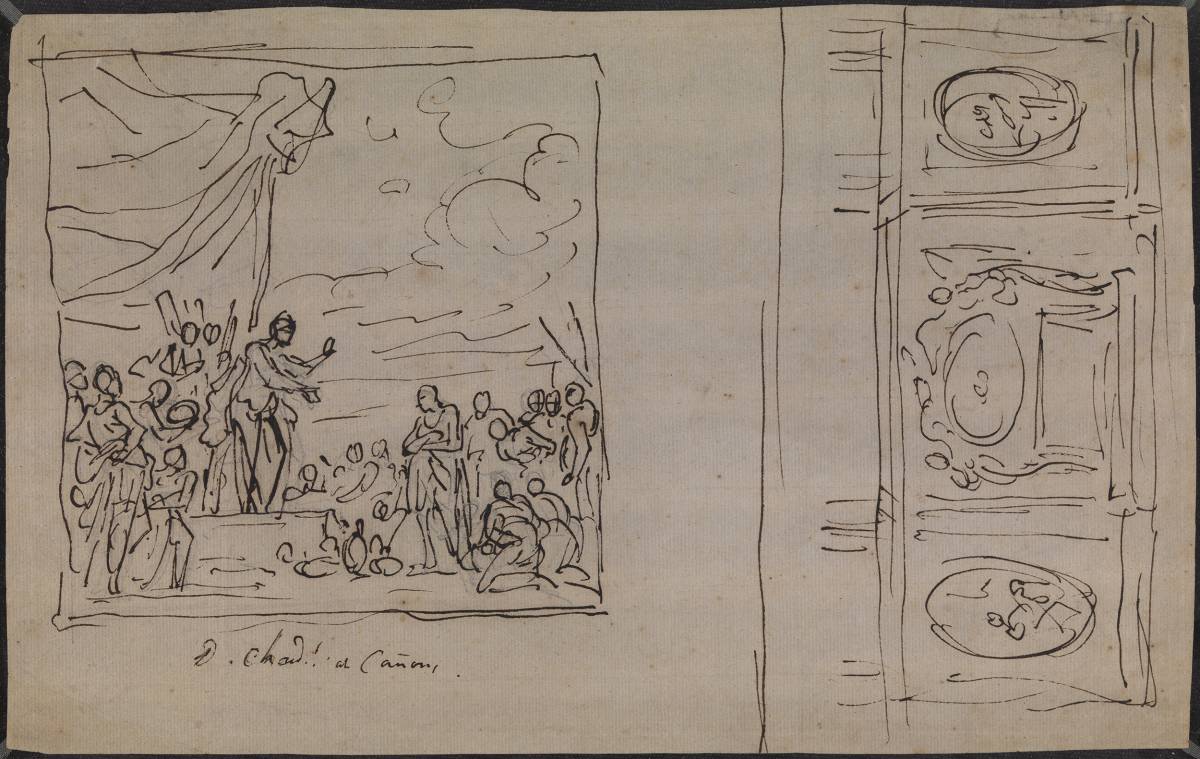This is an early design for the decoration of the staircase at Canons, Little Stanmore in Middlesex, which was one of the early eighteenth century's great palaces of art. Canons was built between 1714 and 1723 by James Brydges, 1st Duke of Chandos to designs by James Gibbs. The Duke was a patron of music as well as painting, and Handel was employed as his resident composer in 1717-18. After his death, though, the late Duke's debts were so severe that his collections were auctioned off and Canons itself was sold before being dismantled for building material in about 1750.
This dynamic sheet is the only preparatory study recognised by both Osmun and Croft-Murray for Thornhill's decorations at Canons. On the left is a preliminary sketch for a grand historical panel depicting the meeting of Dido and Aeneas and on the right a study of the decorative articulation of a wall. The scene apparently shows Dido standing on a raised dais in the temple of Juno being approached by Aeneas. Susan Jenkins lists a further three drawings handling scenes with Dido and Aeneas, which she associates with Thornhill’s work for Chandos. A sheet published by Edgard Mayhew shows the same scene as our drawing carefully labelled ‘Dido falls in love wth Æneas in ye Temp: of Juno’, shows the orientation of the scene reversed, with Dido seated.[1] This is the format Thornhill preserves in the finished oil sketch in the Victoria and Albert Museum.
Yet as the 1725 inventory states, the decoration of the staircase was given to Laguerre, so that all of Thornhill's designs remained unexecuted.[2] Thornhill's work at Canons was limited to the Saloon, where he painted a ceiling of Apollo and the Muses valued at £500.[3] If the measurements and valuations in the 1725 inventory are indicative of actual costs, Thornhill was the most expensive decorative painter employed at Canons, for his work was valued at roughly 10s per square yard of painted ceiling. Bellucci and Sleter were valued at 7s, Laguerre at just over 3s and Charles Simon and Henry Trench at about 2s. If the cost of employing Thornhill was the reason for choosing Laguerre, it would not have been the only occasion when Thornhill had priced himself out of work, for in about 1716 at Blenheim Palace the Duchess of Marlborough had replaced him with Laguerre for the same reason.[4]
The right-hand section of the sheet shows Thornhill’s scheme for ground-level architectural painting. At its centre, winged figures stand either side of a rectangular space that are probably intended as the east end of a chapel and may be associated with the church of St Lawrence, near Canons, which served as the Brydges family chapel and was extensively rebuilt by the Duke of Chandos in 1714-16. The winged figures are comparable with a study at Tate Britain for the east end of the chapel at Wimpole, the finished version of which is dated 1724.[5] This sheet was owned in turn by three of the major twentieth century connoisseurs of early English drawings.
References
- Edgard Mayhew, Sketches by Thornhill, exh. cat., London (Victoria and Albert Museum), 1967, p.17, cat. no.24.
- Susan Jenkins, 'An Inventory of His Grace the Duke of Chandos's Seat att Cannons Taken June the 19th 1725' by John Gilbert', Walpole Society, 2005, vol 67, p.131.
- Susan Jenkins, 'An Inventory of His Grace the Duke of Chandos's Seat att Cannons Taken June the 19th 1725' by John Gilbert', Walpole Society, 2005, vol 67, p.119.
- Edward Croft-Murray, Decorative Painting in England 1537-1837, London, 1962, vol.I, p.75.
- Tate, museum no.T08521, National Trust, museum no.207910.


